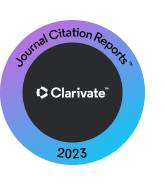TREATMENT OF ACID EFFLUENTS FOR THE REMOVAL OF MANGANESE AND HEAVY METALS ASSOCIATED WITH EFFLUENTS FROM THE COAL MINING THROUGH THE PROCESSES OF FLOCULATION AND FLOTATION BY DISSOLVED AIR
DOI:
https://doi.org/10.5327/z2176-947820200632Keywords:
mine acid drainage; environmental contaminants; toxic metals.Abstract
This study was developed with the objective of evaluating the effluent treatment processes from coal mining, as well as the efficiency in removing manganese and other heavy metals. The procedures consisted of applying mining wastewater treatment methods through the neutralization processes, followed by Flocculation and Sedimentation (NFS) and Dissolved Air Flotation (FAD) on a bench scale. The test via NFS showed an efficiency of 99.58% in the removal of the manganese dissolved in the effluent, with an increase in
pH up to 9.95. For the FAD tests, the average manganese removal efficiency was 97.12% and with pH 9.4. For other metals, NFS showed 99.79% removal for Total Aluminum, 99.32% for Zinc and 97.79% for Soluble Iron, while FAD had an average removal of 96.33% for Total Aluminum, 97.02% for Zinc, and 97.26% for Soluble Iron. All tests fell within the limits established by environmental legislation with respect to the concentration in toxic metals, this proves that the process of treating the effluent from a coal company under study showed an efficiency for the removal of the analyzed metals, especially iron, zinc, and manganese. There remained the need for adjustments in future research work to adapt manganese to pH values below 9.0. It was also found that, in addition to the NFS, the FAD treatment technique constitutes an alternative for the treatment of acid mine effluents, corroborating with previous works and justifying a possible future reintroduction in the systems of treatment of acid mine drainage in the region.
Downloads
References
ASSOCIAÇÃO BRASILEIRA DE NORMAS TÉCNICAS. NBR 9898: Preservação e técnicas de amostragem de afluente líquidos e corpos receptores – Procedimento. Rio de Janeiro: ABNT, 1987.
CAMPANER, V.P.; SILVA, W.L. Processos físico-químicos em drenagem ácida de mina em mineração de carvão no sul do Brasil. Química Nova, São Paulo, v. 32, n. 1, p. 146-152, 2009. https://doi.org/10.1590/S0100-40422009000100028
CONAMA. Resolução n° 430, de 13 de maio de 2011. MMA, 2011. Disponível em: <http://www2.mma.gov.br/port/conama/legiabre.cfm?codlegi=646>. Acesso em: 25 jun. 2020.
FERGUSON, J.E. The heavy elements: chemistry, environmental impact and health effects. Oxford: Pergamon Press, 1991. 190 p.
HAMMARSTROM, J.M.; SIBRELL, P.L.; BELKIN, H.E. Characterization of limestone reacted with acid-mine drainage in a pulsed limestone bed treatment system at the Friendship Hill National Historical Site, Pennsylvania, USA. Applied Geochemistry, v. 18, p. 1705-1721, 2003. https://doi.org/10.1016/S0883-2927(03)00105-7
KALIN, M.; FYSON, A.; WHEELER, W.N. The chemistry of conventional and alternative treatment systems for the neutralization of acid mine drainage. Science of the Total Environment, v. 366, n. 2-3, p. 395-408, 2006. https://doi.org/10.1016/j.scitotenv.2005.11.015
KONTOPOULOS, A. Acid Mine Drainage Control. In: CASTRO, S.H.; VERGARA, F.; SÁNCHEZ, M.A. (orgs.). Efluent Treatment in the Mining Industry. Chile: University of Concepción, 1998. p. 57-118.
MENEZES, C.T.B.; LEAL FILHO, L.S. Tratamento de efluentes ácidos de mina por neutralização e remoção de metais. Boletim Técnico da Escola Politécnica da USP / Departamento de Engenharia de Minas e Petróleo, São Paulo, n. 212, p. 1-20, mar. 2004.
MENEZES, C.T.B.; LEAL FILHO, L.S.; SANTO, E.L; RUBIO, J.; ROSA, J.J.; GALATTO, S.L.; IZIDORO, G. Tratamento de Drenagem Ácida de Mina: Experiência da Carbonífera Metropolitana. IN: ENCONTRO NACIONAL DE TRATAMENTO DE MINÉRIOS E METALURGIA EXTRATIVA, 20., 2004. Anais... Florianópolis, 2004.
MENEZES, C.T.B.; TABOADA, A.E.; CHAVES, A.P. Flotação do carvão no Brasil. In: CHAVES, A.P. (org.). Flotação: o estado da arte no Brasil. São Paulo: Signus, 2006. v. 4. p. 369-379. (Coleção Teoria e Prática do Tratamento de Minérios).
OLIVEIRA, A.L.; OLIVEIRA, N.F. Flotação por ar dissolvido aplicada no tratamento de efluente de leitos de drenagem. Revista DAE, n. 218, v. 67, 2019. https://doi.org/10.4322/dae.2019.032
POTGIETER-VERMAAK, S.S.; POTGIETER, J.H.; MONAMA, P.; VAN GRIEKEN, R. Comparison of limestone, dolomite and fly ash as pre-treatment agents for acid mine drainage. Minerals Engineering, v. 19, n. 5, p. 454-462, 2006. https://doi.org/10.1016/j.mineng.2005.07.009
RUBIO, J.; TESSELE, F. Processos para o Tratamento de Efluentes da Mineração. In: BENVINDO, A.L.; SAMPAIO, J.A.; ALMEIDA, S.L.M. (orgs.). Tratamento de Minérios. 3. ed. Rio de Janeiro: CETEM/MCT, 2002. p. 637-697.
SHRIVER, D.F.; ATKINS, P.W.; LANGFORD, C.H. Inorganic chemistry. 6. ed. Oxford: Oxford University Press, 1998. 819 p.
SILVAS, F.P.C.; BUZZI, D.C.; BERNARDES, A.M.; ESPINOA, D.C.R.; TENÓRIO, J.A.S. Caracterização e neutralização de drenagens ácidas de minas provenientes da mineração de carvão em Santa Catarina. Revista Brasileira de Ciências Ambientais, n. 20, 2011.
TRINDADE, R.B.E.; SOARES, P.S.M.; RIZZO, A.C.L. Remoção de manganês residual contido em efluentes aquosos de mineração. In: ENCONTRO NACIONAL DE TRATAMENTO DE MINÉRIOS E METALURGIA EXTRATIVA, 20., 2004. Anais... Florianópolis, 2004.
VOLPATO, S.B.; MENEZES, C.T.B.; SILVA, J.V.F. Recuperação ambiental de ecossistemas aquáticos em regiões estuarinas: estudos aplicados para o tratamento de sedimentos contaminados pela drenagem ácida de mina na Bacia Hidrográfica do Rio Urussanga, Santa Catarina. Engenharia Sanitária e Ambiental, v. 22, n. 2, p. 313-316, 2017. https://doi.org/10.1590/s1413-41522016126487
WOLOSZYN, D.; VOLKART, P.A.; BIZANI, D. Tratamento de efluente secundário proveniente do beneficiamento do carvão mineral utilizando bactérias com capacidade redutora de sulfato. Revista Brasileira de Ciências Ambientais (RBCIAMB), n. 28, 2013.
Downloads
Published
How to Cite
Issue
Section
License
Copyright (c) 2020 Revista Brasileira de Ciências Ambientais

This work is licensed under a Creative Commons Attribution 4.0 International License.

























